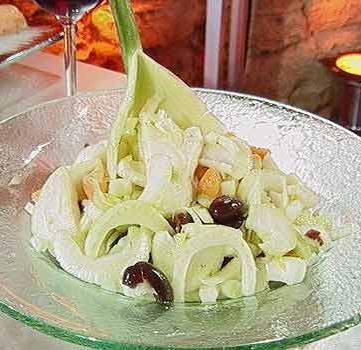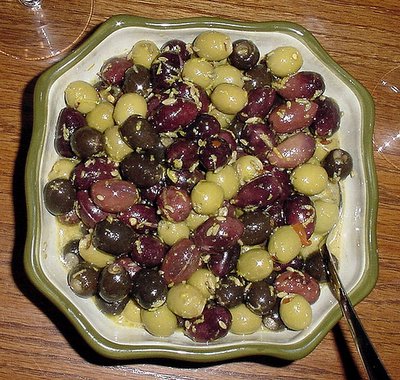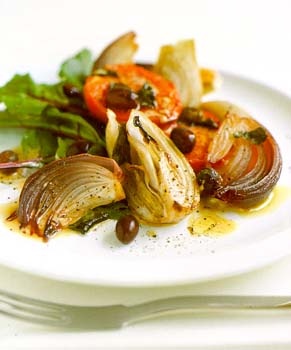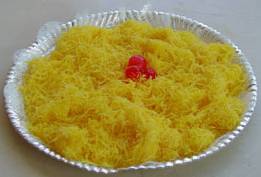
Arabic ????, ???, ????, ????, ???????
?????, ??????, ????? Shamaar, Shamar, Shamraa, Shoumar, Shumar, Razianaj
English Sweet cumin
French Fenouil, Aneth doux
Hebrew שומר Shumar
Italian Finocchio
Portuguese Funcho
Spanish Hinojo
This valuable herb has edible, licorice-flavored leaf stalks and seeds.
This plant is often sold in markets as anise, another member of the carrot family.
Much like a licorice-flavored celery, fennel is crisp and crunchy with a pronounced flavor when raw. Cooked fennel has a much milder anise flavor and a soft, not stringy texture.
As fennel is native to the Mediterranean, it is most typical for the cuisines of Southern Europe. It is used for meats and poultry, but even more for fish and see food. Fennel is rather popular in Southern France and often contained in the Proven?al spice mixture herbes de Provence (see lavender).
Italians are particularly fond of fennel, employing it for many different kinds of foods, e.g., for sausages or pasta sauces. It is often contained, together with herbs (thyme, oregano), in the olive oil based marinades for vegetables and, sometimes, sea foods. The marinated vegetables are usually eaten as appetizers (antipasti), together with white bread and red wine.
Fennel pollen has a spicy-ethereal fennel scent that best complements fruity flavours as found in Italian food, particularly in South Italy. For example, I like risotto with tomatoes, fennel pollen and a hint of thyme. Being less robust than fennel fruits, fennel pollen should be added late in the cooking process, or even just before serving.
 Dried fennel fruits
Dried fennel fruits (often called
seeds)
they retain a green colour after drying. As a rule of thumb, a bright green colour indicates a good quality.
Ground or whole fennel seeds are used in stuffings, sausages, breads, cookies, cakes, candies and liqueurs.
In Italy, there is also small-scale usage of fennel pollen as an expensive and rather extravagant spice. Also known as “Spice of the Angels”, fennel pollen is also produced in California as a small-scale exotic crop.

The
leaves and stalks of fennel can be eaten as a vegetable. The leaves are used in salads, sauces and soups. Italian breeds with fleshy stem and leaves to be used as a vegetable are often referred to as “Florence Fennel” or “Finocchio” in English, but the name finocchio may mean any type of fennel in Italian.
Fennel is an underused and underrated vegetable. Most people have heard of it but many people have never eaten it. In Roman Britain bunches of fennel were hung outside houses to ward off witches. But did you know that fennel is a natural digestive aid - in fact, the crushed seeds are used in infants gripe water to help with colic. It is also a mild diuretic and can soothe an irritated stomach. Fennel can be eaten raw but its delicious lightly steamed and is especially good to offset fatty foods such as pork and oily fish.
Selection: Choose large, firm, crisp fennel with creamy white bulbs and bright green fronds.
Storage and handling: Fennel will keep in a plastic bag in the refrigerator for 3-4 days.
Preparation: Remove the fronds (reserve for use as an herb) and stalks. Trim a thick slice from the root end and slice the bulb in half. Remove the core from each half. Slice or chop if desired. Steam whole fennel bulbs in a basket over boiling water, covered, 8-15 minutes if you’ll finish cooking by some other method, or 20-35 minutes till tender if serving immediately. Microwave whole bulbs in a covered dish with a little water, 8-10 minutes.
Serving suggestions: Add chilled raw fennel to salads or vegetable trays. The bulb is often used in Mediterranean dishes (SIS, p. 124). Boil diced bulb and add to rice, pasta,
or polenta. Use the fronds for garnishes.
Nutrients: Vitamin C; potassium; fiber.
1 lb raw = 2 1?2 - 3 cups
1 lb cooked = 2 1?4 cups
 onion salad
onion salad
 נפלו עליכם אורחים במפתיע?
נפלו עליכם אורחים במפתיע? onion salad
onion salad

































